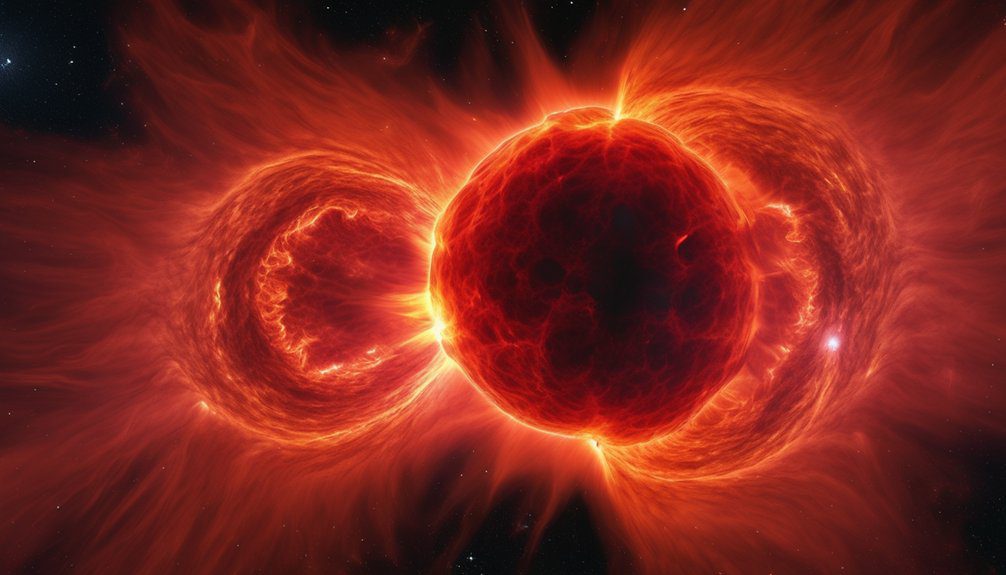Before a star goes supernova, it uses up hydrogen in its core, causing the core to shrink and heat while fusion continues in a surrounding shell. Heavy elements then form in layers around the core until an iron core develops, which can no longer produce fusion energy. Once the iron core reaches a critical mass, it collapses rapidly, forming a neutron star. This collapse triggers a shockwave revived by neutrinos, resulting in a supernova explosion. Understanding these stages clarifies massive star evolution and cosmic impacts.
Core Hydrogen Depletion and Shell Burning
Once a star exhausts the hydrogen fuel in its core, it can no longer sustain the nuclear fusion reactions that had balanced gravitational forces.
You’ll see the core shrink under gravity, increasing temperature and pressure. Hydrogen fusion then shifts to a surrounding shell, where hydrogen still exists.
This shell burning produces energy that pushes outward, causing the star’s outer layers to expand. You might notice the star grows larger and cooler on the surface during this phase.
This change marks a critical step in the star’s life, setting the stage for subsequent fusion processes and its eventual fate.
Formation of an Iron Core
As the star continues to burn heavier elements in successive shells around the core, it gradually builds up an iron core at its center.
Iron forms because it’s the most stable element, meaning fusion beyond iron doesn’t release energy. This stability causes the star to accumulate iron without the ability to produce further energy through fusion.
As the iron core grows, it becomes increasingly dense and hot. You can think of this phase as the star’s final step before instability sets in, as the iron core’s presence signifies the end of energy-generating fusion in the star’s core.
Core Collapse and Neutron Star Formation
When the iron core reaches a critical mass, it can no longer support the star against gravity’s relentless pull. The core collapses rapidly, compressing protons and electrons into neutrons, forming a dense neutron star. This collapse releases immense gravitational energy and halts once nuclear density is achieved.
You’ll find these key points essential:
- Core shrinks dramatically within seconds
- Neutron degeneracy pressure balances gravity
- Intense density creates a compact neutron star
- Surrounding layers react to the sudden core change
Understanding this phase helps you grasp how stars evolve from stability to the brink of explosive transformation.
Triggering the Supernova Explosion
Although the neutron star forms rapidly, it alone doesn’t cause the supernova explosion. Instead, the explosion triggers when the collapsing core rebounds, sending shockwaves outward.
These shockwaves stall initially but revive as neutrinos, produced in vast amounts by the dense core, transfer energy to the surrounding material. This energy deposit pushes the star’s outer layers away in a powerful blast.
You see, the balance between gravitational collapse and neutrino-driven pressure is critical. Understanding this process frees you to appreciate how massive stars end their lives, shaping the cosmos with their explosive deaths.
Frequently Asked Questions
How Long Does the Entire Supernova Process Take?
The entire supernova process takes just seconds to minutes once it starts, but the star spends millions of years evolving beforehand. You’ll see a brilliant explosion that outshines entire galaxies before fading away quickly.
Can a Supernova Affect Planets in Its Solar System?
Yes, a supernova can devastate planets in its solar system by blasting intense radiation and shockwaves. You’d want to avoid being nearby since it can strip atmospheres and obliterate any chance for life to survive.
What Elements Are Produced by Supernova Explosions?
Supernova explosions produce heavy elements like iron, gold, and uranium. You’ll find these elements scattered across space, seeding new stars and planets—giving you the building blocks for life and everything around you.
Are All Dying Stars Destined to Become Supernovae?
No, not all dying stars become supernovae. You’ll find only massive stars explode that way, while smaller ones quietly fade into white dwarfs. So, your star’s fate depends on its size and mass.
How Do Astronomers Detect a Star Before It Goes Supernova?
You spot a star nearing supernova by tracking sudden brightness changes, unusual X-ray or neutrino emissions, and spectral shifts. Astronomers use telescopes and sensors to catch these signals before the explosive finale.







